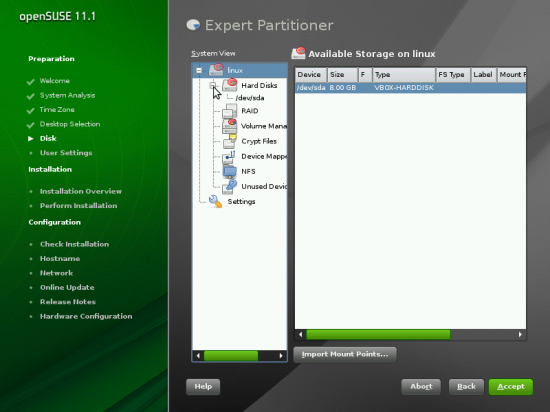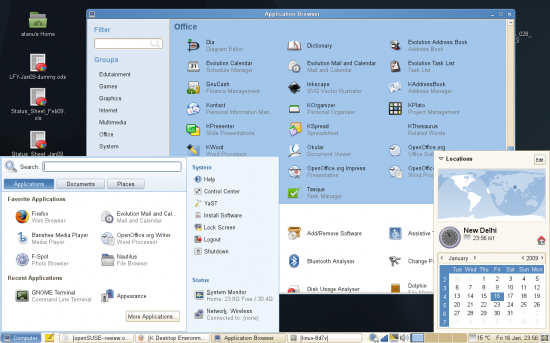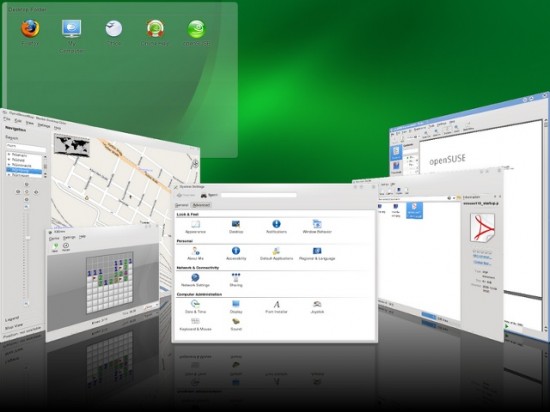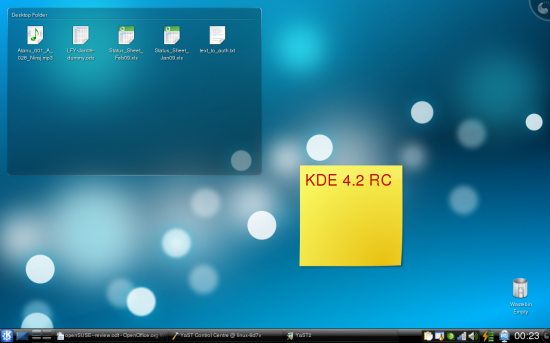This time around I tried my hands on the openSUSE 11.1 64-bit version as soon as it was released last December. After a month or so, I’m still using it as the default OS on my PC. So, what caused the switch from Mandriva? Well, it’s the openSUSE Build Service. Build Service, as you know, is this pretty cool service, where newer software packages are made available for a particular openSUSE version—so, you no longer have to wait for the new OS version to come out in order to check an updated version of an application. My decision was purely based on the fact that KDE 4.2 is around the corner (scheduled for release on January 27), so I didn’t want to wait till April for Mandriva 2009 Spring to try it.
In fact, I’m writing this article on KDE 4.2 RC (which was released on January 13) after ‘fusing’ it with the final openSUSE 11.1 DVD that was released in December. However, before we get into all that, let’s see what the vanilla openSUSE has in its bag.
The basics (or plain boring details)
Linux 2.6.27.7, glibc 2.9, KDE 4.1.3 (3.5.10 is also available as an option), GNOME 2.24.1, OpenOffice.org 3.0, GIMP 2.6.2, and more or less all the software updated to their current versions is what the v11.1 DVD is all about. What sets the openSUSE DVD apart from other distros is that the 3.5 branch of KDE is also available for those who still don’t want to switch to KDE4 for whatever reason.
The first thing you’ll notice during the installation is the brand new ‘free’ licence, which finally replaces the old Novell EULA. The distro, which is an aggregate of various free software, has been relicensed under GPL version 2. This means the DVD now doesn’t contain non-free software like Adobe Acrobat Reader, Flash, and the like, any more. This also means you are not required to select an ‘Accept’ check box any more, but simply move on after reading the licence (if you so choose).
The rest of the installation routine has remained very similar to openSUSE 11.0 (if not exactly the same—you can read my article on v11.0 in LINUX For You’s August 2008 issue if you want to know the steps). The other thing to note is the redesigned partitioner. Although I’d hoped that any change introduced should make things a bit easier (or more appealing?), I felt that’s certainly not the case here. In fact, the redesign is sort of awkward and may leave you a bit puzzled.

After installation, the boot-up time and overall performance of the desktop is pretty decent, and comparable to the previous version. Here again, there’s nothing much to report as we’ve already talked enough about the recent KDE and GNOME versions, and have seen how they look and feel in the distros that have been bundled with LFY since November. However, if I may add, the all-around green openSUSE theme that was introduced in version 10.3 and continues till date can get on your nerves, and I personally would appreciate it if they switched back to the pleasant bluish look and feel.
One thing I’d still like to report is that openSUSE’s default selection of applications and the overall integration of the desktop is still top-notch. Although I’d have preferred it if the SUSE folks did something about the Slab menu that they introduced in GNOME with SUSE Linux Enterprise 10 in 2006. Not that I’m saying it’s not pretty compared to the default GNOME menu, but when it comes to usability, it’s a hideous show-stopper, expecting the user to wait and click several times to find and launch an application. I guess if the GNOME users are looking for a better menu alternative, Gimme is a much better option, with some good features, although it’d still need some love from the UI design team to make it prettier.

Something else that’s new with v11.1 is the complete integration of PackageKit (the GUI package manager front-end introduced by the Fedora camp) across desktop environments. Likewise, along with the YaST’s software manager, you can also use this front-end (available in the menu by the name of Add/Remove Software) instead. Personally, I’d have preferred if there was only one front-end available by default. And considering that the YaST package manager GUI for GNOME is so hideous-looking, it’d be neat if the SUSE team focuses on the development of PackageKit full time (to make the GUI better and the software work faster). Not that I’m very comfortable with PackageKit either, as I use the traditional YaST package manager that is accessible from KDE.

Something very handy about the distro is that the package manager automatically installs things like Flash or Fluendo plug-ins for MP3 support and nvidia/ATI graphics drivers the moment you try and install anything using YaST for the first time. So, if you are a free software purist, you better disable the non-free repository first.
Personally, I’d recommend adding the Packman repository before doing anything, and then simply executing zypper dup from the command line as the root user. This will pull in all the codec libraries from this third-party repository and you’ll have pretty decent multimedia support without trying to search and select the codecs manually. Of course, anything that you find missing afterwards can be searched for later.
By the way, if you use one of those Broadcom wireless chipsets, then you can install the broadcom-wl-kmp-default (as well as broadcom-wl) package from the Packman repository. These are the Linux drivers that were finally released by Broadcom a while back, so there’s no need to depend on ndiswrapper or fwcutter for wireless support any more (if you so choose).
The final point to mention here is that the KDE 4.1.3 version offered is not the vanilla upstream version. It has a handful of features backported from the KDE 4.2 beta branch also, which is indeed nice for us KDE users. However, I’ll say why settle with ‘some’ backported features only, when kde.org hosts a KDE 4.2 RC Live CD (which I was talking about earlier; and by the time you read this, the final version would be out) on an openSUSE 11.1 base?
4.2: Come to my window
…crawl inside, wait by the light of the moon. Come to my window, I’ll be home soon.
Say, what now? Nothing really… I was just trying to impersonate Melissa Etheridge to make KDE 4.2 come to me faster. Seems like it doesn’t work this way.
Anyway, on January 14, I headed to home.kde.org/~binner/kde-four-live to grab the Live CD. (Note that I could have configured the ‘KDE4-UNSTABLE-desktop’ repository on a base openSUSE 11.1 install to pull in the KDE 4.2 RC packages, but what fun is that?) The added advantage of using this CD is that you can also take a look at the progress of KOffice 2.0 and K3b 2.0 with the included beta releases.
To install the Live CD you can follow the same steps as you would when you install the DVD. Now, after installation, I obviously needed OpenOffice.org, in addition to the English UK translations and support, as well as the GNOME desktop. Of course, I could have pulled everything from the online repository. But why waste time when I already had the DVD handy?
Adding the DVD as an install source is simple: YaST→Sorfware Repositories; in the ‘Configured Software Repositories’ window click Add; select the DVD radio button, and follow the steps. That’s it! Now, open the YaST package manager and install the rest of the software you need. Simple, isn’t it? Of course, by the time you read this article, the final KDE 4.2 will be out, so you should check that out.

Now, I know you expect me to talk about what’s new in KDE 4.2, but I won’t do that. All I can say is it’s a brilliant update with really nice features and a sexier interface. What can I say, other than that I’m loving it!
Bottomline
So, where do we really stand? I’ll say, whether you want to try KDE 4.2 or not, it doesn’t really matter. What matters is that if you are an openSUSE user, this is a ‘must’ upgrade. And if you aren’t an openSUSE user, well, it’s certainly worth a try—at least for the sake of being able to quickly get started with KDE 4.2 without waiting for your distro to release its next version after a few months with the updated desktop.
By the way, the news is that the next version of openSUSE will give v4.2 a skip, and straight away bring forth v4.3.
















































































i'm new to linux.i don't know how install the kde4.2 in the suse.please explain with more fiqures.because i don't know the comments.
i'm new to linux.i don't know how install the kde4.2 in the suse.please explain with more fiqures.because i don't know the comments.